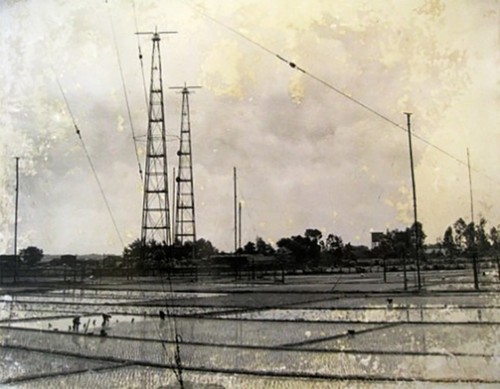 Antennas at the Me Tri transmission station in Hanoi during war time. Antennas at the Me Tri transmission station in Hanoi during war time. |
The US’s Operation Linebacker II from December 18 to 29 targeted major facilities in Hanoi, Hai Phong, and other northern localities. The Me Tri transmission station in Hanoi was hit, but VOV continued to broadcast, keeping domestic and foreign audiences informed of what was happening in Vietnam during its just struggle for national independence and liberation.
Indonesian editor Susanto, aka Le Van Tho, started working for VOV in 1971. He recalled, “On December 16, 1972, VOV evacuated its employees to Hanoi’s outlying district of Quoc Oai, two days before the bombing began. In our Indonesian section, two people stayed in Hanoi. News stories were produced in Quoc Oai and recorded and broadcast in Hanoi.”
“Many aircraft droned overhead and during the fighting in the evening, Hanoi’s sky lit up like a fireworks show. We kept working despite the bombardment,” said Tho.
Presenter Kieu Oanh said, “I had served as a presenter at VOV since 1964. During the US air strikes, I worked with presenter Tuyet Mai as a team. Rain or shine, day or night, we cycled to work despite the risk of bombings.”
Dang Trung Hieu, a former VOV technician, said, “The Me Tri station was hit but the audience could still catch VOV programs on the 290m frequency soon after. VOV had been well prepared for any contingencies to avoid interruption of its transmission.”
The 290m (1010Khz) was one of VOV’s 5 frequencies on the morning of December 19 when the Me Tri station was attacked. Just 9 minutes after the destruction of the Me Tri station, VOV’s broadcasting on the 290m frequency resumed.
In his memoir marking 40 years since the battle of “Dien Bien Phu in the air”, journalist Vinh Tra, former Director of VOV’s Editorial Secretariat, said, “After this 9-minute event, VOV received a lot of commendation letters and messages from soldiers on the southern battlefields and overseas Vietnamese and foreign friends from all over the world. Japanese listeners raised 5 million yen to help rebuild the Me Tri station.”
Vinh Tra quoted then Deputy Commander of the Southern Vietnam Liberation Armed Forces Nguyen Thi Dinh as saying, “I was listening to VOV in the early morning of December 12 when the broadcast suddenly stopped. I felt like my heart stopped beating. I was anxious and worried. They attacked the radio station. How was Hanoi? Could we defend the capital? But 9 minutes later, VOV’s transmission resumed. I was overwhelmed with joy.”
The memory of the historic moment is still fresh in Vinh Tra’s mind. “Leaders of VOV, the Government and the Defense Ministry had an overarching vision in preparing for the war. Then VOV President Tran Lam devised a thorough plan to avoid any interruption of the signal, prepare human resources for any contingency, and create updated, high-quality programs which could reach the audience as rapidly as possible,” said Vinh Tra.
During the anti-French war, President HCM said, “VOV must keep the voice of the Party, State and people uninterrupted in any circumstance.” VOV has been doing its utmost to keep President Ho’s word.